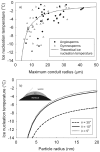Anatomical regulation of ice nucleation and cavitation helps trees to survive freezing and drought stress
- PMID: 23778457
- PMCID: PMC3686780
- DOI: 10.1038/srep02031
Anatomical regulation of ice nucleation and cavitation helps trees to survive freezing and drought stress
Abstract
Water in the xylem, the water transport system of plants, is vulnerable to freezing and cavitation, i.e. to phase change from liquid to ice or gaseous phase. The former is a threat in cold and the latter in dry environmental conditions. Here we show that a small xylem conduit diameter, which has previously been shown to be associated with lower cavitation pressure thus making a plant more drought resistant, is also associated with a decrease in the temperature required for ice nucleation in the xylem. Thus the susceptibility of freezing and cavitation are linked together in the xylem of plants. We explain this linkage by the regulation of the sizes of the nuclei catalysing freezing and drought cavitation. Our results offer better understanding of the similarities of adaption of plants to cold and drought stress, and offer new insights into the ability of plants to adapt to the changing environment.
Figures






References
-
- Tyree M. T. & Sperry J. S. Vulnerability of xylem to cavitation and embolism. Annu. Rev. Plant Physiol. Plant Mol. Biol. 40, 19–38 (1989).
-
- West G. B., Brown J. H. & Enquist B. J. A general model for the origin of allometric scaling laws in biology. Science 276, 122–126 (1997). - PubMed
-
- McDowell N. et al. Mechanisms of plant survival and mortality during drought: why do some plants survive while others succumb to drought? New Phytol. 178, 719–739 (2008). - PubMed
-
- Choat B. et al. Global convergence in the vulnerability of forests to drought. Nature 491, 752–755 (2012). - PubMed
-
- Wheeler J. K., Sperry J. S., Hacke U. G. & Hoang N. Inter-vessel pitting and cavitation in woody Rosaceae and other vesselled plants: a basis for a safety versus efficiency trade-off in xylem transport. Plant Cell Environ. 28, 800–812 (2005).
Publication types
MeSH terms
Substances
Grants and funding
LinkOut - more resources
Full Text Sources
Other Literature Sources

